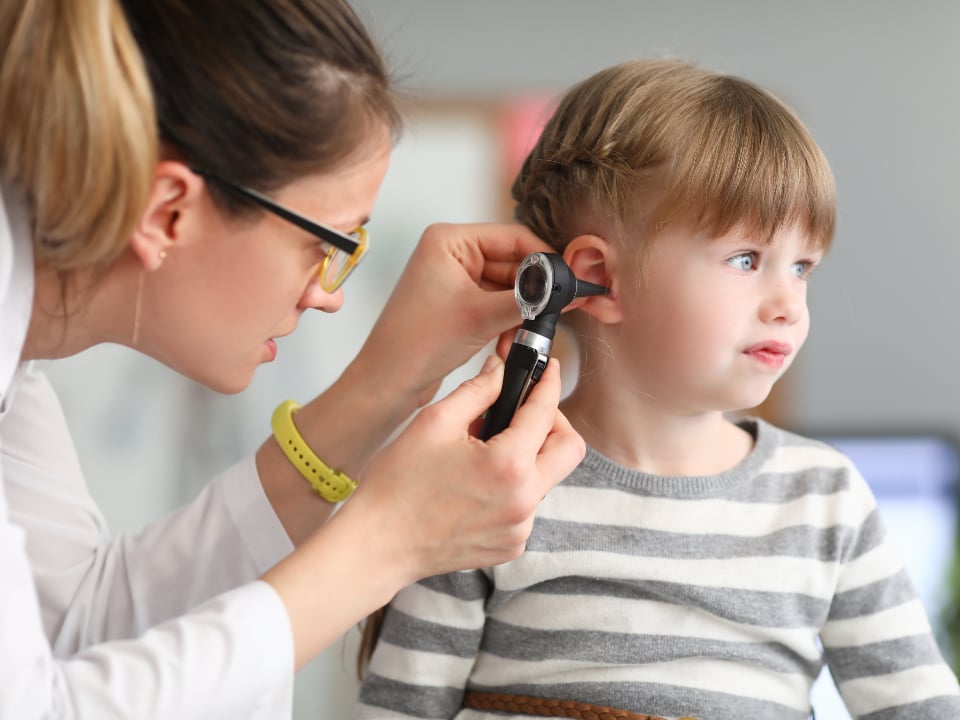
Author: Dr. Keni, CHOC Pediatrician
As a parent, you’ve probably noticed that ear pain has a way of striking at the most inconvenient times–often after a fun day at the pool or beach. If your child is tugging at their ear and complaining of discomfort following water activities, they may be experiencing swimmer’s ear.
This common condition affects thousands of children each year, but with the right knowledge, it’s both treatable and preventable. Below, let’s take a look at what swimmer’s ear really is and how you can keep your child comfortable and healthy during water season.
What is Swimmer’s Ear?
Swimmer’s ear, medically known as otitis externa, affects the outer part of your child’s ear rather than the inner ear infections you might be more familiar with.
This condition occurs when the external ear canal becomes inflamed due to bacterial or fungal growth. When water gets trapped in the ear canal–whether from swimming, bathing, or even humid conditions–it creates a warm, moist environment where bacteria and fungi can thrive, leading to infection and discomfort.
Symptoms & Causes
What are the symptoms of swimmer’s ear?
Every child experiences discomfort differently, but swimmer’s ear typically presents with some telltale signs that parents can easily recognize. Being able to identify these symptoms early can help you get your child the care they need:
- Redness of the outer ear
- Itching in the ear
- Pain, especially when touching or wiggling the ear lobe
- Drainage from the ear
- Swollen glands in the neck
- Swollen ear canal
- Conductive hearing loss
The symptoms of swimmer’s ear may resemble other medical conditions or problems. Always consult a healthcare provider for a diagnosis.
What causes swimmer’s ear?
While the name suggests swimming is the only culprit, swimmer’s ear can actually develop from various factors that create the perfect environment for bacteria and fungi to grow. Other possible causes include:
- Being in warm, humid places
- Harsh cleaning of the ear canal
- Trauma to the ear canal
- Dry ear canal skin
- Foreign body in the ear canal
- Lack of cerumen (ear wax)
- Eczema and other forms of dermatitis
Diagnosis & Treatments
How do we diagnose swimmer’s ear?
When you bring your child in with a suspected swimmer’s ear, their healthcare provider will use gentle, child-friendly methods to confirm the diagnosis and rule out other conditions, starting with a complete medical history and physical examination. They may use an otoscope, a lighted instrument that helps to examine the ear and to aid in the diagnosis of ear disorders, to help determine if there is also an infection in the middle ear, called otitis media. Although this infection usually does not occur with swimmer’s ear, some children may have both types of infections.
How do we treat swimmer’s ear?
Swimmer’s ear, when properly treated by a healthcare provider, usually clears up within seven to 10 days. Specific treatment for otitis externa will be determined by your child’s provider based on:
- Your child’s age, overall health, and medical history
- Extent of the condition
- Your child’s tolerance for specific medications, procedures, or therapies
- Expectations for the course of the condition
- Your opinion or preference
Treatment may include:
- Antibiotic ear drops
- Steroid ear drops (to help decrease the swelling)
- Pain medication
- Keeping the ear dry, as directed by your child’s healthcare provider
- In severe cases, an otolaryngologist may place a special piece of cotton, called an ear wick, within the ear canal to help antibiotic drops reach the eardrum.
How can I help my child prevent swimmer’s ear?
Prevention is always the best medicine, especially when it comes to keeping your child comfortable during summer activities. To prevent swimmer’s ear, we recommend that you take steps to protect your child’s ear canals from water during swimming and bathing. This can be done using cotton balls coated in vaseline or with earplugs. We also recommend that you avoid aggressively cleaning your child’s ear canal with Q-tips or other potentially harmful objects, like bobby pins.
When to Seek Care
If your child is experiencing ear pain, drainage, or other symptoms of swimmer’s ear, don’t wait for the discomfort to worsen. At Marque Medical, our experienced providers–including CHOC pediatricians at select locations–are here to help diagnose and treat swimmer’s ear quickly and effectively. We understand that ear pain can be particularly distressing for children, and we’re committed to providing gentle, compassionate care that gets your little one feeling better fast.
Whether you choose an in-person visit or a virtual consultation, we’re here to help your family enjoy a healthy, happy summer.
The information provided is for general interest only and should not be misconstrued as a diagnosis, prognosis or treatment recommendation. This information does not in any way constitute the practice of medicine, or any other health care profession. Readers are directed to consult their health care provider regarding their specific health situation. Marque Medical is not liable for any action taken by a reader based upon this information.


